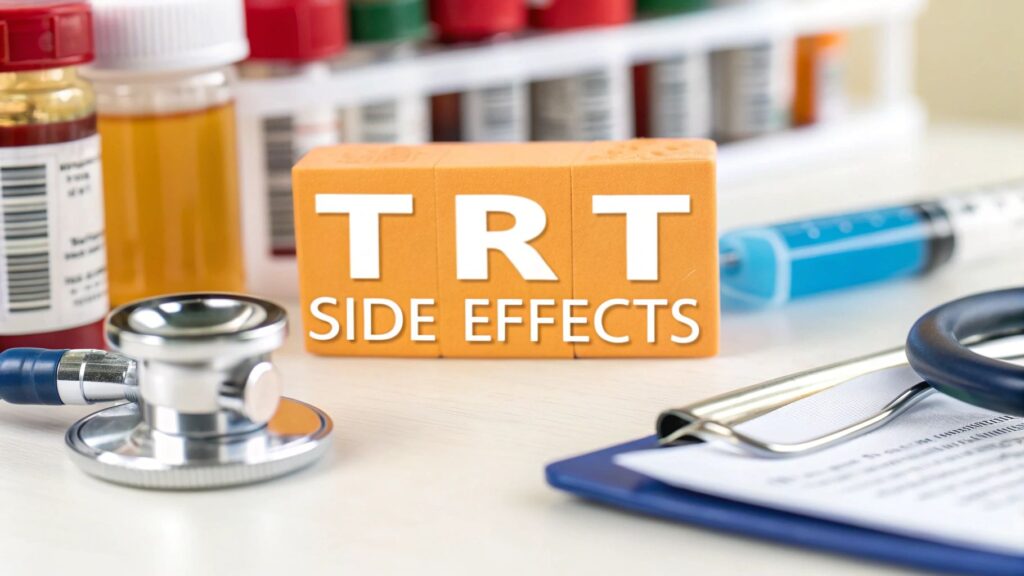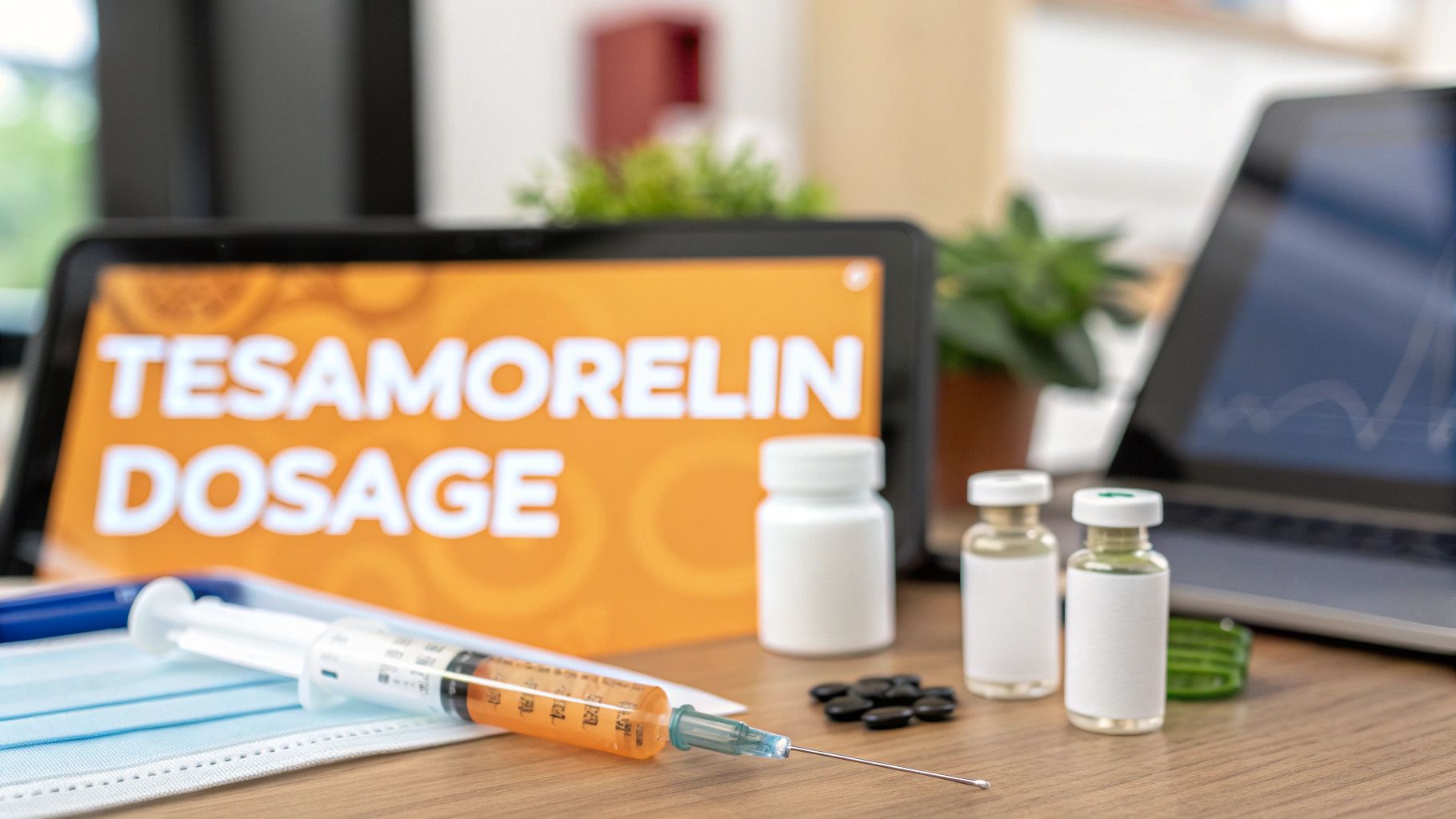Deciding to start testosterone replacement therapy (TRT) is a huge step toward getting your old self back—your energy, your drive, your vitality. While you're probably focused on all the good things to come, it's just as important to have a clear-eyed view of the potential testosterone therapy side effects. This guide will give you an honest look at the risks involved, so you can have a productive conversation with your doctor and make a decision that's right for you.
Weighing the Benefits and Risks of TRT
Embarking on TRT can feel like you're navigating a complex map. One path leads to the destination you want: relief from nagging symptoms like fatigue, low libido, and brain fog. But along the way, there are potential roadblocks and detours—the side effects. Understanding this entire landscape is the first step toward a safe and successful journey.
Think of your body's hormonal system as a finely tuned orchestra. When testosterone is low, a key instrument is out of sync. TRT aims to bring that powerful instrument back into the mix to restore harmony. But adding it back in requires careful calibration to ensure it doesn’t overpower the other sections. This is why TRT isn't just about starting a prescription; it's about forming a partnership with your healthcare provider.
The Role of Proactive Management
The key to minimizing risks isn't reacting to problems after they appear—it's being proactive from day one. This means taking a comprehensive approach that starts long before your first dose and continues for the entire duration of your treatment. The goal is to catch any potential issues early, often before they even become noticeable.
This smart management strategy includes:
- Initial Health Screening: A thorough evaluation of your baseline health is non-negotiable. This includes comprehensive blood work and assessments of your cardiovascular and prostate health.
- Personalized Dosing: Your doctor should prescribe a dose tailored specifically to your body's needs. A one-size-fits-all approach is a recipe for problems.
- Ongoing Adjustments: Doses aren't set in stone. They should be adjusted based on how your body responds and what your regular lab results show, all to maintain optimal levels.
A common misconception is that side effects are just part of the deal. In reality, many are preventable or easily managed through careful oversight. Consistent communication with your doctor and sticking to your prescribed plan are your best tools for a positive outcome.
Ultimately, balancing the powerful benefits of TRT with its potential side effects comes down to diligent oversight. You can learn more about the critical nature of this process by understanding why monitoring testosterone replacement therapy is important. This commitment to careful tracking is what helps ensure your path to better health remains smooth and safe.
Common Physical Changes You Might Experience

Starting testosterone replacement therapy (TRT) means reintroducing a major hormone, which often sends your body into an adjustment period. Think of it as a sort of second puberty, where your system has to get used to a new set of hormonal signals. These initial physical changes are usually the first things you'll notice, and knowing what to expect is key to a smooth process.
Many of these adjustments are pretty mild and often temporary. For instance, increased testosterone can kick your skin's oil glands into higher gear. This might lead to oilier skin or even some acne breakouts, much like what many guys go through in their teenage years.
Another common initial effect is fluid retention. You might notice some slight swelling, or edema, in your ankles and feet as your body works to recalibrate its fluid and salt balance. This is one of the more common testosterone therapy side effects, but it’s something your doctor can typically manage quite easily.
Changes Related to Hormonal Conversion
Testosterone doesn’t always stay testosterone once it's in your body. Through a natural process called aromatization, a small amount can be converted into estrogen. While men absolutely need some estrogen to stay healthy, an imbalance can trigger certain side effects.
The one most guys worry about is gynecomastia, which is the enlargement of male breast tissue. This happens when estrogen levels climb too high relative to testosterone, stimulating the glandular tissue in the chest. While it definitely sounds concerning, it's a known possibility that your doctor will be actively monitoring for.
It's important to remember that many physical side effects are dose-dependent. A slight adjustment to your dosage or administration method, made by your healthcare provider, can often resolve these issues without stopping treatment.
Managing these changes is a team effort between you and your doctor. They'll keep a close eye on your hormone levels to make sure everything stays in a healthy, balanced range. For those curious about how different delivery methods might affect these levels, you can learn more about the differences between testosterone oral vs. injection therapies and figure out what makes the most sense for you.
Other Potential Physical Adjustments
Beyond the more common shifts, TRT can affect other areas as well. It’s crucial to be aware of the full spectrum of possibilities so you can report anything new to your physician right away.
Some men might notice:
- Changes in Hair: For guys genetically prone to male pattern baldness, TRT can sometimes speed up hair thinning on the scalp. On the flip side, you might see an increase in body hair growth.
- Testicular Atrophy: When your body starts getting testosterone from an external source, its own natural production can dial down. This can lead to a reduction in testicle size over time, which is often reversible if you ever decide to stop therapy.
Keeping an open line of communication with your medical team ensures any of these physical side effects are addressed quickly and effectively, letting you focus on the benefits of your therapy.
How TRT Can Affect Your Blood Health
While many of TRT's effects are things you can see and feel, one of the most important changes your doctor needs to watch for happens silently within your bloodstream. Testosterone plays a direct role in signaling your bone marrow—the body's factory for red blood cells—to kick production into a higher gear.
Think of your bloodstream as a busy highway. Normally, traffic flows just fine. But when TRT tells your body to make more red blood cells, it’s like suddenly merging thousands of extra cars onto the road. Before long, you’ve got a traffic jam.
In medical terms, this condition is known as erythrocytosis (or polycythemia). It simply means your blood has become thicker and more viscous. This "sludgy" blood doesn't move as easily through your vessels, which can raise the risk for blood clots and potentially lead to serious events like a deep vein thrombosis (DVT), pulmonary embolism, or even a stroke.
Why Regular Blood Tests Are Essential
You can’t feel your red blood cell count creeping up, which is why consistent blood tests are an absolutely non-negotiable part of safe and effective TRT. Your doctor will keep a close eye on two key measurements:
- Hemoglobin: The protein inside your red blood cells that's responsible for carrying oxygen.
- Hematocrit: The percentage of your total blood volume that is made up of red blood cells.
This increase in red blood cell mass is one of the most well-documented side effects of testosterone therapy. A significant body of research confirms that TRT can cause a noticeable jump in both hemoglobin and hematocrit levels. This change is directly tied to the increased blood viscosity that elevates the risk of blood clots. For a deeper dive, you can review the full findings on testosterone's impact on red blood cells to understand the data yourself.
The image below gives you a clear visual of how often this increase in red blood cell count (polycythemia) occurs compared to other long-term risks linked to TRT.

As you can see, polycythemia is a real and notable concern, but it’s one that’s easily managed with diligent medical supervision.
To help you keep track, this table provides a quick overview of the key side effects your doctor will monitor, including what you should look out for and how it's typically managed.
Key TRT Side Effects and How They Are Tracked
| Side Effect | Common Signs to Watch For | Typical Medical Monitoring |
|---|---|---|
| Erythrocytosis (High Red Blood Cells) | Usually no symptoms; detected via blood tests. | Regular hemoglobin and hematocrit checks. |
| Prostate Health Changes | Changes in urination, frequent urination at night. | PSA (Prostate-Specific Antigen) blood tests, digital rectal exams. |
| Estrogen Imbalance | Mood swings, water retention, sensitive nipples. | Estradiol (E2) blood tests. |
| Skin Issues (Acne/Oily Skin) | Breakouts on the face, shoulders, or back. | Physical examination and patient reporting. |
| Fluid Retention | Swelling in ankles or feet, feeling "puffy." | Physical examination, blood pressure monitoring. |
Staying on top of this monitoring schedule is the best way to ensure your therapy remains both safe and effective.
Managing and Preventing High Red Blood Cell Counts
The good news is that erythrocytosis is a highly manageable side effect. If your routine blood work shows your hematocrit levels are climbing too high—generally above 54%—your doctor has a couple of very safe and effective tools to bring things back into a healthy range.
Proactive management is the name of the game. Here’s how a provider will typically respond:
- Dose Adjustment: More often than not, the first step is to simply lower your testosterone dose. This dials back the stimulation on your bone marrow, allowing red blood cell production to return to normal.
- Therapeutic Phlebotomy: This sounds complicated, but it's a straightforward procedure that's identical to donating blood. A specific amount of blood is drawn to immediately lower the concentration of red blood cells, effectively thinning the blood and dropping your hematocrit.
Think of therapeutic phlebotomy as a controlled 'reset' for your bloodstream. By removing a small volume of blood, your doctor can quickly and safely restore proper flow, much like clearing a logjam in a river.
This proactive approach ensures that one of the more serious testosterone therapy side effects remains a well-controlled and very low-risk issue. Sticking to your monitoring schedule and keeping the lines of communication open with your doctor are your best defenses, allowing you to get all the benefits of TRT without putting your blood health at risk.
Understanding the Impact on Heart Health

The link between testosterone therapy and heart health has been a hot topic for years. To get a clear picture, you have to look at both the old concerns and the much more reassuring data from new, large-scale studies. The real key is understanding how TRT actually interacts with your cardiovascular system.
Often, the potential risks tie back to other testosterone therapy side effects we’ve already discussed. For instance, if testosterone revs up your red blood cell production too much (erythrocytosis), your blood gets "thicker," which can raise the risk of clotting. In the same way, fluid retention can increase blood pressure, putting extra strain on your heart.
It’s also crucial to think about the indirect effects. Take sleep apnea—TRT can sometimes make it worse, and unmanaged sleep apnea is a major independent risk factor for heart problems. This just goes to show why a holistic view of your health is so important during therapy.
The Evolving Medical Consensus
For a long time, the cardiovascular risks associated with testosterone were hazy at best, creating a lot of anxiety, especially for older men. Some early studies hinted at a higher risk of heart-related events, but many of them were small or had design flaws. The one finding that consistently popped up was the increase in red blood cell count, which could theoretically lead to clots, heart attacks, or strokes. You can see how these cardiovascular considerations have been evaluated in TRT by looking at some of the foundational research.
But medical understanding is always moving forward. A landmark study published in 2023 finally brought some much-needed clarity. It was a big one, tracking over 5,000 men between the ages of 45 and 80. The verdict? When properly managed to bring testosterone into the normal range, TRT did not increase the risk of heart attack or stroke compared to a placebo.
This newer research is a game-changer for both patients and doctors. It shifts the conversation from avoiding therapy because of vague fears to managing it safely with careful, personalized medical oversight.
Now, that doesn't mean the discussion is over. The very same study pointed out a slight increase in the risk of atrial fibrillation, which is an irregular heartbeat. It hammers home a critical point: no medical treatment is completely risk-free. The goal is to sit down with your doctor and weigh the potential risks against the proven benefits.
Your Proactive Role in Heart Health
With all this in mind, the focus now is squarely on proactive screening and consistent monitoring. Before you even think about starting TRT, your doctor needs to do a thorough cardiovascular evaluation to establish your baseline risk.
This initial check-up is absolutely vital if you have:
- A personal history of heart disease, heart attack, or stroke.
- Pre-existing conditions like high blood pressure or high cholesterol.
- A strong family history of cardiovascular problems.
Once you’re on treatment, ongoing monitoring makes sure any changes are spotted early. This partnership with your provider is what allows you to safely chase the benefits of balanced hormones while keeping your long-term heart health protected.
Navigating Prostate Health During Therapy
For a lot of men, the word "testosterone" immediately brings the prostate to mind. It's a completely valid concern and one of the most common topics that comes up when discussing TRT. So, let’s clear the air and look at what today's medical science actually says about this crucial connection.
The biggest fear is usually prostate cancer. The good news is that the old belief that testosterone therapy causes prostate cancer has been largely debunked by modern evidence. A better way to think about it is this: testosterone doesn't start the fire, but if a fire is already smoldering, it could potentially act as fuel.
If a man has an undetected, pre-existing prostate cancer, adding more testosterone to the mix could speed up its growth. This is exactly why a comprehensive prostate screening is a mandatory first step before even considering treatment. This isn't just a suggestion; it's a critical safety checkpoint.
Benign Prostatic Hyperplasia and Urinary Symptoms
A much more common issue is how TRT affects a non-cancerous condition called benign prostatic hyperplasia (BPH), also known as an enlarged prostate. Many older men already have some degree of BPH. Since testosterone can stimulate the growth of prostate tissue, therapy might make existing BPH symptoms worse.
This can lead to some really frustrating lower urinary tract symptoms (LUTS), including:
- A frequent or urgent need to urinate, especially at night
- Trouble getting the urine stream started
- A weak or stop-and-start urine stream
- Feeling like you can’t fully empty your bladder
While current reviews show TRT doesn't consistently raise the risk of developing prostate cancer, it can potentially worsen BPH and its related urinary symptoms. This is precisely why your prostate-specific antigen (PSA) levels have to be checked regularly. You can learn more about these prostate health findings to see the full scope of the research.
Your doctor’s job is to make sure the benefits of TRT clearly outweigh any potential risks. Through careful screening up front and consistent monitoring, they can track any changes in your prostate health and adjust your treatment plan to keep you safe.
The Importance of Consistent Monitoring
Your prostate health strategy doesn't just stop after the initial screening. It's an ongoing process. Regular monitoring throughout your therapy is the absolute cornerstone of safe and effective treatment. Your doctor will keep a close eye on your PSA levels with routine blood tests. A significant or unusually rapid jump in your PSA could be a signal that something needs a closer look.
This proactive approach allows your doctor to catch any potential issues early on, long before they become serious problems. While TRT can impact the prostate, it's a very manageable part of the therapy. In a similar vein, many men also wonder if hormone replacement therapy causes hair loss, another side effect that really depends on individual genetics and careful management.
By staying on top of your follow-up appointments, you and your doctor can work as a team to protect your long-term prostate health. This ensures you can enjoy all the benefits of therapy with complete peace of mind.
Your Top Questions About TRT Side Effects, Answered

Stepping into testosterone replacement therapy can feel like navigating new territory, and it’s natural to have a lot of questions. We’ve put together straightforward answers to the most common concerns we hear about testosterone therapy side effects.
The goal here is to clear up the confusion and address the practical worries you might have. This information will help you walk into your doctor’s office feeling more confident and ready for a productive conversation about your health.
Are the Side Effects of Testosterone Therapy Permanent?
This is probably the number one question on most guys' minds, and the answer is reassuring: most side effects are not permanent. Common issues like a bit of acne, mild fluid retention, or even a bump in red blood cell counts are almost always reversible.
These effects are typically tied directly to your dosage. If they pop up, your doctor can often resolve them by simply adjusting your dose or, in some cases, pausing therapy. The key is to report any new symptoms right away so they can be managed before they become a bigger problem.
However, a few changes might be harder to reverse. For example, if you're already genetically prone to male pattern baldness, TRT can sometimes speed that process up. This is exactly why it's so important to go over your entire family and personal health history with your doctor.
How Can I Lower My Risk of Experiencing Side Effects?
Minimizing your risk is a team effort between you and your doctor. It all starts with making sure you have a legitimate medical need for TRT, confirmed through proper blood tests and a thorough diagnosis. A comprehensive screening beforehand is crucial to catch any underlying conditions that could be complicated by therapy.
From there, sticking to your prescribed treatment plan is non-negotiable. This means using the exact dose your doctor sets and never trying to adjust it on your own. Showing up for all your follow-up appointments and getting your blood work done on schedule is the only way to manage TRT safely.
Your lifestyle is your best support system. A balanced diet, regular exercise, keeping stress in check, and getting enough sleep all help your body adapt to the hormonal changes. You’re essentially creating a healthier internal environment for the treatment to do its job.
Does the Type of TRT I Use Change the Side Effects?
Absolutely. The delivery method—whether you’re using gels, injections, patches, or pills—can definitely influence the side effects you might experience. Each option comes with its own set of pros and cons that your doctor will consider when designing your plan.
Here’s a quick look at how they can differ:
- Topical Gels: The biggest issue here is the risk of transference. You have to be careful that the hormone doesn't accidentally rub off on women or children through skin contact.
- Injections: This method can sometimes create hormonal "peaks and valleys" between shots. For some guys, this might lead to more noticeable shifts in mood or energy levels.
- Oral Formulations: The latest oral options are far safer than the old-school pills from decades ago. Still, it's vital to only use FDA-approved formulas under a doctor's watch to avoid any potential stress on the liver.
Your doctor will walk you through these options to find the best fit for your health profile, lifestyle, and personal preference, aiming for the best results with the fewest drawbacks.
Can Testosterone Therapy Cause Mood Swings or Roid Rage?
This is a huge misconception, mostly fueled by media portrayals of anabolic steroid abuse. While poorly managed TRT could potentially lead to some irritability, the goal is actually to stabilize your mood by correcting a hormone deficiency.
The aggressive behavior known as "roid rage" is linked to supraphysiological doses of anabolic steroids—levels that are many, many times higher than what's prescribed for legitimate medical therapy. The entire point of TRT is to bring your testosterone levels back into a normal, healthy range, not blast them into the stratosphere. When managed correctly by a qualified doctor, severe mood swings are extremely unlikely.
Ready to explore your options with a team of experts? Elite Bioscience provides medically supervised hormone therapies designed for your unique health goals. Take the first step toward reclaiming your vitality by completing our confidential health assessment today. Visit us at https://elitebioscience.co to learn more.







